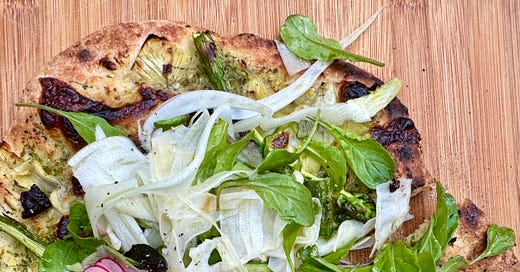
It all started with a jar of artichokes. Steve said, “I noticed you froze some pizza dough. Maybe we could fire up the Ooni and make some pizza with the artichokes.” Sounds simple enough. A few years ago, my friend Bryan Ford came to my house and we had a little pizza party. At the end, he said I could keep the oven (which was already well-used) because he had a brand new one at home. This one had a cracked stone, which doesn't really affect its performance. I am a live-fire enthusiast, but working with a wood-fired pizza oven is something I didn't have any experience with, so the oven has been sitting — outside, in the elements — for two years now, unused.
Like anyone trying something new, I was a little hesitant, not knowing exactly what to expect. But last night was the night. It was quite an undertaking for a weeknight dinner for two, and I’m really glad I didn't invite anyone over for pizza because it started out as an epic fail — but then it got better. There is definitely a learning curve, and I probably should have read more before I started rather than diving right in. The one video I did watch said it would take 15 to 20 minutes to heat the oven. Ha! That was way off and not at all helpful! It took more like an hour of constantly stoking the fire to get the stone hot enough to cook pizza properly. Once the oven started getting really hot, the stone still wasn't hot enough, so I made a few pies that were burnt on top and white on the bottom. The last pizza I made was finally cooked on the bottom, but next time I will get the stone even hotter. Now I get it.
Did I mention that as the oven heated up, water that was trapped in all the nooks and crannies (from leaving it out in the elements) started to boil and seep out? Yeah, that may have slowed things down too. Needless to say, I'll be getting a cover for the Ooni and an infrared thermometer before I attempt this again!
Luckily, there are other, easier ways to cook pizza! Like in the oven on a stone or steel, where you have lots of control over the temperature. Or maybe in a gas-powered outdoor pizza oven. I do love the smokiness and almost burnt-ness of the wood-fired pizza and will definitely be trying it again, but in the meantime, making pizza in the oven or on the grill is a no-brainer, and a great casual dinner option now that the lazy days are starting.
The reason I had dough in the freezer was that I tried Alexandra Stafford’s thin crust pizza dough a few weeks ago to celebrate the publication of her book, Pizza Night. I made a little reel for Instagram, which has become a fun way for me to try out recipes from books I like. So last night, I defrosted that thin-crust dough, but I also wanted to try her “Neapolitanish” Pizza Dough, so I started a batch of that in the morning. Ali generally recommends (as I do) starting doughs at least a day before you plan to use them so they can cold-ferment for up to three days in the refrigerator, where they become more flavorful and textured. But she also gives you short-cut options if you’re a last-minute person, which yesterday, I was.
For more info and pizza tips galore, check out Ali’s Substack, Pizza Every Friday.
I happened to be feeding my sourdough starter yesterday, so I decided to go the sourdough route for the Neapolitanish dough and let it rise all day at room temperature. By the time I was ready to cook pizza, the dough was ready. Alexandra was nice enough to share her dough recipe with Susanality readers (find it below!), which hopefully will inspire you to start making pizza from scratch. If you’re looking for instant gratification, I’m also including my Asparagus Pizza with Arugula Salad recipe from Veg Forward, which includes a yeast-risen dough that can be ready to go in about an hour.

My first pizza of the night was meant to be a rough recreation of that pizza, though I swapped the olives for artichoke hearts. The salad I created was a simple one meant to be piled right on top of the pizza, which is a combo I love. Steve rolled his up like a taco, which was a pro move. I prepped lots of other toppings too, because that’s the fun part about making pizza. Once you have the dough, you can get as creative as you want with each pie. There are no rules for this part.


I was worried we’d still be hungry after our pizza appetizer (haha no, we weren’t) so I picked up some shrimp. I figured I’d throw those in a pan (I used my current favorite Made In perforated grill pan, but actually a solid pan might have been the better choice here, because some ash got into our food) along with any leftover pizza toppings and the remaining salad on the side. It was a perfect no-waste solution and provided us with a simple secondi after our pizza feast.
Now onto the recipes! Have I convinced you to have a pizza night one day soon?
Asparagus Pizza with Arugula Salad
Makes 2 pizzas
A cool, acidic salad piled onto a hot pizza is one of the best things in life. Something about the contrast of the hot cheese and crust wrapped around the salad is so satisfying (yes, I give you permission to fold your slice). The salad wilts just a little, but mostly stays fresh. I like to buy bunches of arugula with larger leaves, but any kind of arugula will work.
For the pizza:
1 recipe pizza dough (recipe follows), left at room temperature for 1 hour if previously chilled
All-purpose flour, for handling the dough
4 teaspoons olive oil, divided, plus more for brushing
1 cup ricotta, preferably fresh, or 6 ounces soft goat cheese (or a combination of both)
6 ounces fresh mozzarella, torn into pieces
28 spears asparagus (1 ½ bunches), trimmed and halved lengthwise unless pencil-thin
1 jalapeño, thinly sliced
Kosher salt and freshly ground pepper
For the salad:
3 cups arugula
12 Castelvetrano olives (about 1/2 cup) or other green olives, pitted and halved
1 tablespoon lemon juice
2 teaspoons olive oil
Kosher salt and freshly ground pepper
Heat oven to 500℉, or the highest setting, with a baking steel or stone inside on the center rack. Heat for 45 minutes. If you don't have a steel or stone, you can heat a rimmed baking sheet upside-down on the center rack for at least 15 minutes.
To make the pizza: Scrape the dough out of the bowl onto a generously floured surface. Divide into 2 equal pieces using a bench scraper, handling the dough as little as possible. Cut a 12-inch sheet of parchment, spray or brush it with olive oil, and place on a pizza peel (or the back side of a rimmed sheet pan or a rimless cookie sheet).
Transfer one piece of dough to the parchment and, with floured hands, gently stretch into a roughly 12-inch circle. Top with dollops of half the ricotta or crumbles of half the goat cheese, and the mozzarella, scattering evenly.
Toss half the asparagus and the jalapeño with 1 teaspoon oil to coat and lightly season with salt and pepper. Scatter the vegetable mixture on the pizza, drizzle with 1 teaspoon olive oil, and slide the pizza, right on the parchment, onto the steel, stone, or heated sheet pan.
Bake for 10 to 12 minutes, until the crust is well-browned on the edges and the cheese is bubbling. Use the peel to scoop up the pizza, giving a little tug on the paper to help if needed, and transfer to a serving board. Repeat to make the second pizza.
To make the salad: Toss the arugula with the olive oil, lemon juice, olives, salt, and pepper. Top the pizza with the salad and serve immediately.
NOTE: If you want to make only one pizza, freeze the other round of dough to use another time. Defrost overnight in fridge before using.
Pizza Dough
Makes enough for 2 (12-inch) pizzas
This dough is very soft and hydrated, which makes for a bubbly, chewy texture when baked. Don't be afraid to use plenty of flour when handling the dough, which will make it easier to work with. Don’t incorporate it into the dough; it will toughen it.
1/2 teaspoon active dry yeast
1 ¼ cup/270 g warm water
2 ⅓ cups/298 g bread flour or all-purpose flour
1 ½ teaspoons/5 g kosher salt
Olive oil, for the bowl
Sprinkle yeast over the warm water to dissolve it. Whisk flour and salt in a large bowl. Stir in the yeast mixture until fully incorporated. Cover and let stand 10 to 15 minutes.
Dampen your hand and give the dough a few turns in the bowl until slightly smooth. Make four “stretch and fold” movements, scooping your hand from under the dough, stretching it up, and folding the dough over on itself. Turn it over and tuck the sides in so you have a smooth, taut ball. Transfer to a clean, oiled bowl, and turn the dough over a few times to make sure the surface is oiled. Cover with plastic wrap and refrigerate overnight and for as long as 3 days. Alternatively, if you want to bake the same day, let the dough rise at room temperature until doubled, about one hour.
When ready to use, remove from the fridge about an hour before needed so it can come back to room temperature.
Neapolitanish Pizza Dough
By Alexandra Stafford
If you live in a humid environment or are new to pizza making, start with 425 grams of water. The dough may feel dry immediately after mixing, but as the dough rises, the flour will continue to hydrate, and when you turn out the dough to portion it, it will feel much wetter and stickier. If you are an experienced pizza maker and don’t mind working with a higher hydration dough, you can use 450 grams of water to start.
Timeline: 1½ to 3 days
Makes four 245-to 250-gram balls
550 grams (about 4 ¼ cups) bread flour or all-purpose flour, plus more for dusting
15 grams salt
2 grams (about 1/2 teaspoon) instant yeast
425 to 450 grams (1 ¾ to 2 cups) cold (about 60°F) water
Extra-virgin olive oil
Mix the dough: In a large bowl, whisk together the flour, salt, and yeast. Add the water and use a spatula to mix until the dough comes together, forming a sticky dough ball. If the dough is dry, use your hands to gently knead it in the bowl until it comes together. Cover the bowl with a towel and let rest for at least 15 minutes and up to 30 minutes.
Stretch and fold: Fill a small bowl with water. Dip one hand into the bowl of water, then use the dry hand to stabilize the bowl while you grab an edge of the dough with your wet hand, pull up, and fold it toward the center. Repeat this stretching and folding motion 8 to 10 times, turning the bowl 90 degrees after each set. By the end, the dough should transform from shaggy in texture to smooth and cohesive.
Pour about 1 teaspoon of olive oil over the dough and use your hands to rub it all over. Cover the bowl tightly and let the dough rise at room temperature until it has nearly doubled in volume, 6 to 10 hours. The time will vary depending on the time of year and the temperature of your kitchen.
Portion the dough: Turn the dough out onto a lightly floured work surface and use a bench scraper to divide the dough into 4 equal portions, roughly 245 to 250 grams each. Using flour as needed, form each portion into a ball by grabbing the edges of the dough and pulling them toward the center to create a rough ball. Then flip the ball over, cup both your hands around the dough, and drag it toward you, creating tension as you pull. Repeat this cupping and dragging until you have a tight ball.
Store the dough: Place the dough balls in individual airtight containers and transfer to the fridge for 1 to 3 days.
Notes:
Some important notes about the Neapolitanish Pizza Dough recipe, which appear on other pages in the book:
If using an outdoor pizza oven, drop the water amount to 385 grams.
If you want to speed up the timeline, mix the dough in the morning, let it rise all day at room temperature, portion, ball, and use 1 hour later.
Editor: Molly Ramsey








this sounds so delicious and Love Ali's new book!!
Hi Susan, big fan and proud owner of both veg forward and pizza night! I’m used to 70% hydration pizza dough recipes, but had a lot of trouble with these - especially getting the ball smooth and taut after just 4 stretch and folds. Any tips for working with high hydration dough without completely mangling it?
Thanks!!